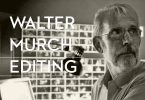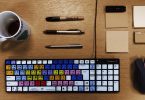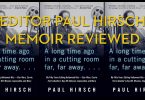The Making of Chappie
Every so often on the blog I end up creating some massive, constantly updated post about a particular film that’s just come out. Somehow often sci-fi movies – it’s not an intentional selection, just ends up that way! You can see what I mean in these previous posts: The Making of Gravity | Making of Godzilla | Making of Interstellar | Making of Elysium | Making of Gone Girl
Director Neill Blomkamp is back again with a further continuation of his grubby sci-fi future, filmmaking trilogy (does District 9 count?) with the 2015 remake of Short Circuit, only much better!
From a post production point of view Neill is once again working with some of his core team including editor Julian Clarke and colorist Andrea Chlebak, who both worked on Elysium. I’ll be updating this post with new behind the scenes material and interviews as and when, so check back soon.
Behind the scenes on Chappie
Wired Magazine has an interesting behind the scenes featurette, largely narrated by director Neill Blomkamp, on the making of the film.
UPDATE – HD Video Pro has a great interview with Director of Photography Trent Opaloch and how he used RED Epics to shoot Chappie and how the DIT team handled the film’s look on-set.
In terms of the workflow, the DP got a dailies drive that he could check each night. “We’d put in a basic look in-camera, but not as much as I’d done on Captain America, which was because of the type of movie it was,” he says. “We basically set an overall tone, scene by scene, and didn’t do too much to it. So it was really back to the old-school system, where we’d do quick little contrast curves and color overall tonal adjustments. And then from our reference folder we would send a reference image so, often, the DIT would do a wide and a tight. So skin tones are represented well, and the overall tonal range of the wide shots are represented, and so then the DI colorist had an overall reference of what we were going for.”
Comingsoon.net has a fairly fast paced interview with Neill and a link to his short film Tetra Vaal, which Chappie is loosely based on. It’s interesting to see what one person can achieve by themselves and what you can achieve with an army of 200 vfx artists. The interview covers the film’s genesis, casting the film and the Hans Zimmer soundtrack.
CS: When you did Tetra Vaal was that also an actor you replaced with CG?
Blomkamp: No, that was different. So I did all of that on a home PC, and the exact reason that I did it was to make it look like expensive VFX so my fake demo reel of fake commercials made me look like I was some hotshot director, which I wasn’t. The only way I could do it was to do it myself, so the way I did it was that I couldn’t afford motion capture but I had a library—I don’t know where I stole it from but I stole a library of moves in motion capture, like a guy walking, a guy jumping. I stole a bunch of moves from some other place and then I shot background plates in South Africa with no actor, knowing that in the gap where there is no actor, there would be a computer-generated robot. So I’d frame stuff for that, and the only time in the whole piece like when the robot is hiding behind a wall and he turns around and returns fire and then hides again. That’s me acting that out and then I roto-animated myself, so I took the motion from me and put it on the droid using key frame animation. Ironically, that was the exact process that we used for Chappie, just on a massive scale.
In the clip below Sharlto Copley, the actor who played Chappie before being replaced by the animated robot version, describes the process and what he thinks is special about the film.
UPDATE: If you enjoy behind the scenes EPK fodder then this 10 minute montage from Extra Flicks, will give you a good dose of Chappie‘s on-set workings. The interesting explosions and what not are towards the end of the clip.
District 9 Editor Julian Clarke
You can hear from Oscar nominated editor, Julian Clarke, in this interview on his work on District 9. They cover how he got to work with director Neill Blomkamp and some of the challenges of the project. You can check out Julian’s credits over on IMDB.
Chappie Visual Effects
As usual FX Guide has a fantastically detailed write up of the visual effects design and execution on the the film, with plenty of behind the scenes photos and videos. There are some really interesting insights on the design, model making, on-set workflow and post production challenges that the director’s requirements created.
After filming, Image Engine launched into a massive postvis effort. “There was a requirement from Neill that in no audience screening would anyone ever see Sharlto,” relates Harvey. “We wrapped end of January and the first audience screening was mid-March, so we had to replace Sharlto with Chappie in every single shot in a two month period – the entire film – in a postvis version.”
It was here that Image Engine experimented with some animation timing, but the results were never intended to be final shots. At the same time, a significant matchmoving, tracking and plate preparation process was carried out – working with RED EPIC plates and anamorphic lenses used by DOP Trent Opaloch. For some of the plates, the film crew had to work quickly and did not acquire the usual LIDAR or set scans to aid in matchmoving, owing to security concerns.
UPDATE
Image Engine have posted a visual effects breakdown of their work on the film. In the 25 minute seminar from NAB below, Earl Fast, Senior Animator from Image Engine, talks through some of the VFX pipeline and how the character animation was created with Autodesk Maya and Shotgun.
Colour Grading Chappie
SKYLAB’s Technical Director, Chris Davies also developed a range of custom LUTs to be applied automatically to particular scenes and VFX layers to ensure each element would work well together in the final grade. “When a project involves as much VFX as Chappie, it is far better for editorial, effects and grading to take place in parallel to avoid the pressures that mount up at the end of a typical DI,” says Davies. SKYLAB’s ACES workflow blends the portability of BLG metadata files into their own MULTIVERSE™ conform architecture.
Chappie‘s colorist Andrea Chlebak and SKYLAB’s Technical Director, Chris Davies share some of the ins and outs of the films Digital Intermediate workflow in this write up from Baselight’s creators FilmLight.







